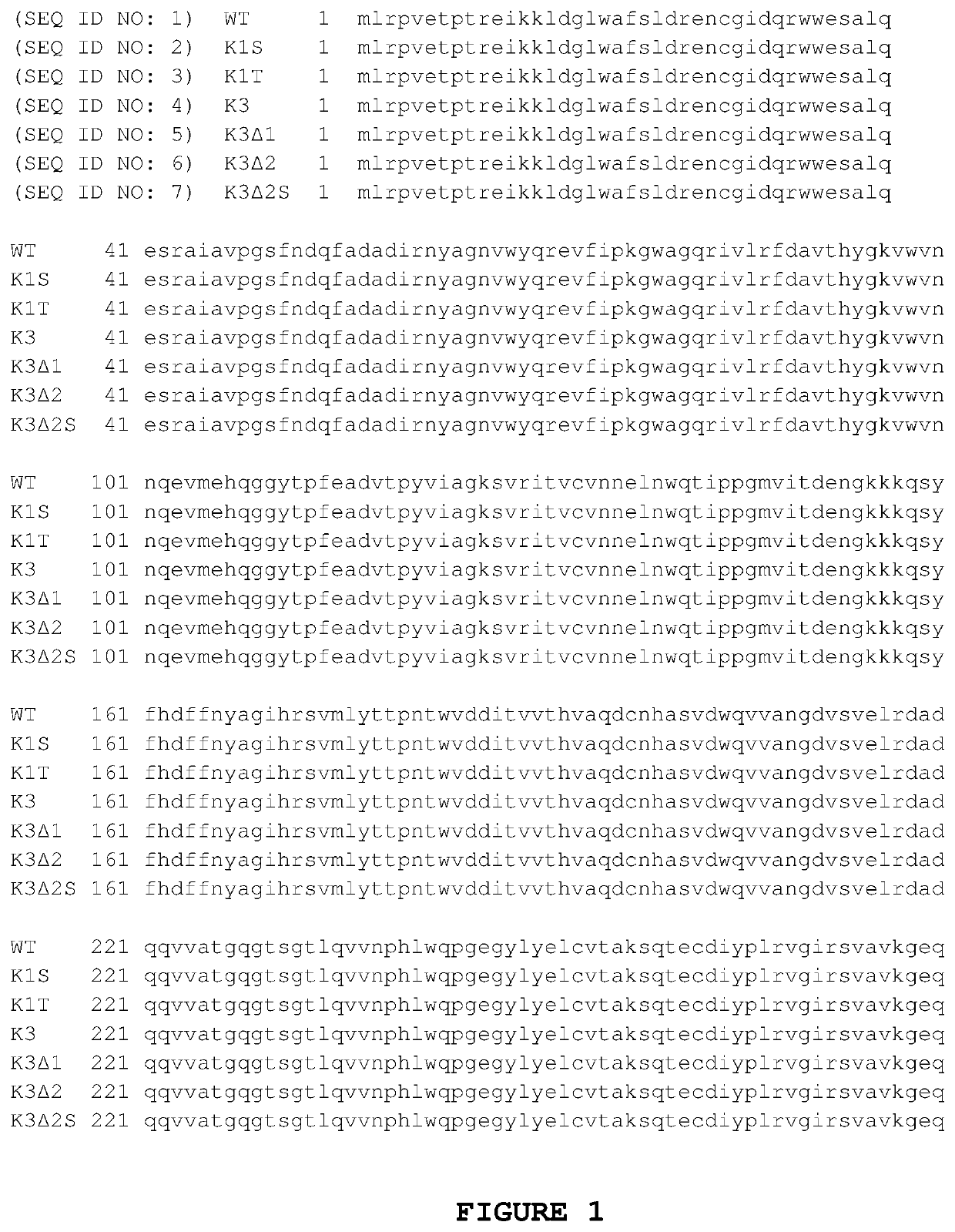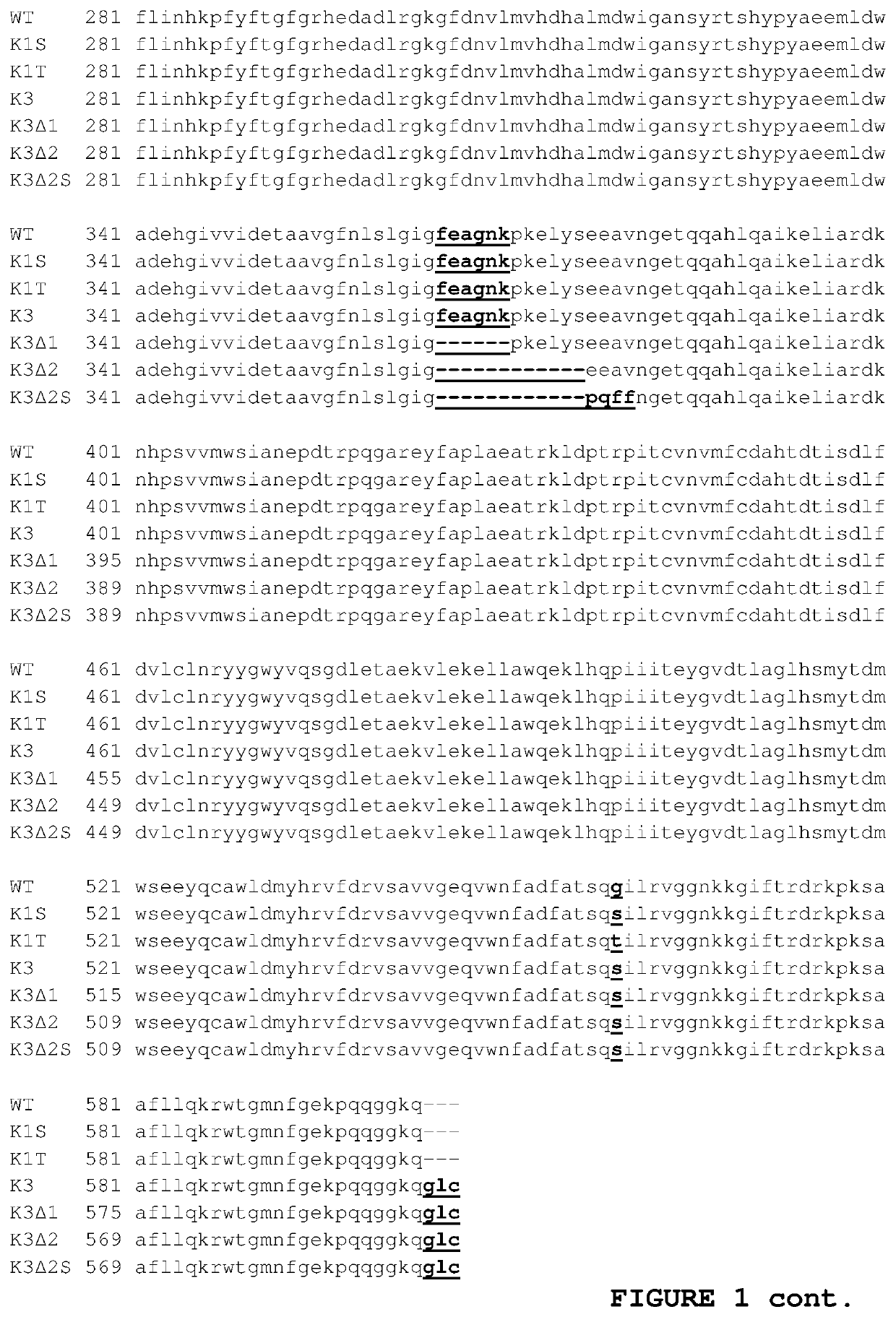Thermostabile beta-glucuronidase formulations
a technology of beta-glucuronidase and formulation, which is applied in the direction of enzymology, biochemistry apparatus and processes, enzyme stabilisation, etc., can solve the problems of not showing enzymatic stability over a wide temperature range or for prolonged periods of time, and achieves low propensity for aggregation, maintain enzymatic activity, and permit freezing/thawing
- Summary
- Abstract
- Description
- Claims
- Application Information
AI Technical Summary
Benefits of technology
Problems solved by technology
Method used
Image
Examples
example 1
of Amino Acids as Thermostabilizers
[0060]In this example, a panel of amino acids was examined for their effect on the melting temperature of the IMCSzyme® genetically modified (mutant) recombinant E. coli β-glucuronidase enzyme. For all experiments described in the Examples, the IMCSzyme® BGUS enzyme (commercially available from Integrated Micro-Chromatography Systems, LLC) was used in the formulations.
[0061]The melting temperature of the enzyme in formulations containing different amino acids was examined using a protein thermal shift assay. For this assay, enzyme protein was purified using standard chromatography techniques to achieve at least >99% purity based on SDS PAGE. Purified recombinant enzyme was initially dialyzed against pure water (18.2 Mohm) with a protein concentration level of at least 2 mg / mL. This stock solution of enzyme in water was mixed 1:1 with various buffer solutions to achieve the final concentration listed in Table 1 below. All samples were then mixed wit...
example 2
of Polyols as Thermostabilizers
[0066]In this example, a panel of polyol sugars was examined for their effect on the melting temperature of the IMCSzyme® genetically modified β-glucuronidase enzyme, using the protein thermal shift assay described in Example 1.
[0067]The results for the panel of polyols tested are shown below in Table 2:
TABLE 2Storage time (weeks)Polyols as stabilizers037.614150 mM D-(+)-Trehalose dihydrate0.21.0−0.315400 mM Xylitol1.81.21.816200 mM D-Sorbitol2.11.6−0.817400 mM Sucrose1.40.92.618400 mM Methyl α-D-glucopyranoside1.9−3.91.6198% v / v Glycerol 40 mM Lithium chloride1.91.00.72010% v / v Glycerol2.01.61.7212% v / v Ethylene glycol0.10.50.6222% v / v Polyethylene glycol 200−3.80.50.2231% v / v Polyethylene glycol −2.9−3.8monomethyl ether 5502410% v / v Polypropylene glycol P 400−9.9−7.4−4.5255% v / v Pentaerythritol ethoxylate −0.20.00.6(15 / 4 EO / OH)262% w / v 1-2-Propanediol−0.4−0.50.1272 mM (2-Hydroxypropyl)-β-cyclodextrin1.31.91.52816 mM α-Cyclodextrin1.30.91.2292 mM β-Cy...
example 3
of Salts as Thermostabilizers
[0069]In this example, a panel of salts was examined for their effect on the melting temperature of the IMCSzyme® genetically modified β-glucuronidase enzyme, using the protein thermal shift assay described in Example 1.
[0070]The results for an initial panel of salts tested are shown below in Table 3:
TABLE 3Time in weeks of storageSalts037.630100 mM Sodium malonate pH 7.0−2.4−1.5−0.231100 mM Succinic acid pH 7.0−1.0−0.90.2321% v / v Tacsimate pH 7.01.11.31.93315% w / v Trichloroacetic acid−32.5−8.3−56.63410 mM EDTA disodium salt dihydrate−5.4−4.5−9.235100 mM Guanidine hydrochloride−4.0−4.0−7.336100 mM Urea1.70.7−0.537100 mM N-Methylurea1.9−1.0−0.43840 mM N-Ethylurea−65.8−4.3−1.03910% v / v Formamide−10.4−6.9−12.4401% w / v Benzamidine hydrochloride−3.7−4.9−14.341100 mM Acetamide1.3−5.5−7.44220 mM MgCl hexahydrate 10 mM −1.6−4.5−7.1CaCl2 dihydrate4520 mM CaCl2 hydrate 10 mM −24.9−25.7−33.5Cobalt(II) chloride44160 mM Non Detergent −19.9−2.4−9.6Sulfobetaine 256 (ND...
PUM
 Login to View More
Login to View More Abstract
Description
Claims
Application Information
 Login to View More
Login to View More - R&D
- Intellectual Property
- Life Sciences
- Materials
- Tech Scout
- Unparalleled Data Quality
- Higher Quality Content
- 60% Fewer Hallucinations
Browse by: Latest US Patents, China's latest patents, Technical Efficacy Thesaurus, Application Domain, Technology Topic, Popular Technical Reports.
© 2025 PatSnap. All rights reserved.Legal|Privacy policy|Modern Slavery Act Transparency Statement|Sitemap|About US| Contact US: help@patsnap.com


